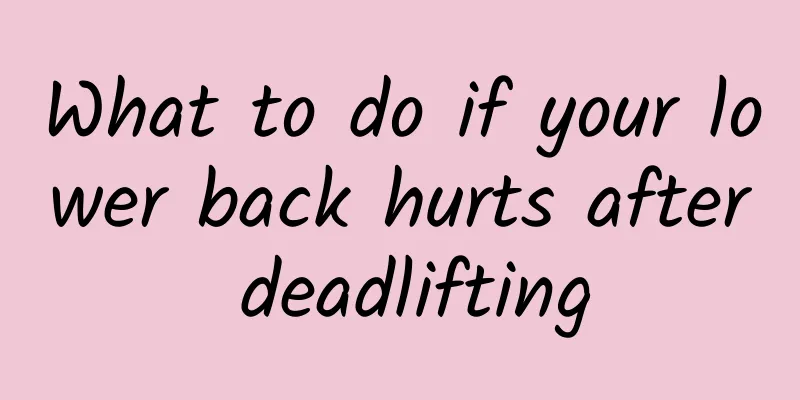What to do if your lower back hurts after deadlifting

|
Deadlift is a common fitness method, but if the method and technique of deadlift is not mastered well, it may cause back pain, which has a relatively large impact on health. When doing this kind of fitness, you must avoid this kind of pain. The main cause of the pain is excessive emphasis on lifting. When pain occurs, certain methods must be taken to relieve it. Causes of lower back pain after deadlifting 1. Too much emphasis on "lifting" The deadlift may seem like a "pulling" exercise, but you should subjectively think of it as a "pushing" exercise. If only lifting is emphasized, the gravity of the exercise load will almost mainly fall on the erector spinae muscles in the lower back, causing a very high risk of lower back injury. In fact, the standard deadlift action requires the use of the hip and thigh muscles, especially in the first half of the deadlift. Subjectively, you should use these muscles more to exert force and have the awareness of pushing off the ground to push the heavy object away. 2. Starting hip position is too high If you pull the weight from a high hip position (such as with a straight-leg deadlift), it will be difficult to use your knee extension power. If you do this, firstly, it will not be conducive to exerting your maximum strength, and secondly, it will put more pressure on your waist. To maximize your knee extension power, you should start with your hips lowered. The specific height of the starting hip position varies from person to person because the proportions of each person's legs and torso are different. So you should focus on the correct starting position to determine the correct starting hip position, and this is the same for people of any body type. 3. Arched back causes turtle pull This is a problem that many people have. The arched back image when deadlifting is called a turtle pull. This will put great pressure on the spine when lifting the barbell, which can easily cause injury. Although it is generally considered safe to just arch your upper back, most people will arch their lower back when they do so, so it is recommended that you keep your entire back straight when doing the deadlift. 4. Hyperextension of the lower back Exaggeratingly arching your back while locking the weight can be as harmful to your spine as the turtle pull. The lumbar spine does not like to be arched or bent significantly, especially when loaded with weight. Weightlifters sometimes need to do this during competition to show the referee that they have locked out the weight. But we shouldn't do this during exercise. We should rely on extending the knees, hips and squeezing the buttocks to lock the weight, and not lean back at the highest point. What to do if your back hurts after a deadlift Acute lumbar muscle sprain, lumbar muscle strain or lumbar disc herniation caused by deadlifting can cause low back pain. It is recommended to go to the orthopedic department of the hospital for diagnosis and treatment. If it is due to acute lumbar muscle sprain, it is recommended to lie down and rest, apply local hot compress, and apply external blood-activating and blood-stasis-removing drugs for treatment. You can rest for one or two days a week, and insist on practicing at other times. First, relieve the pain in the waist: massage the waist and painful area thirty to forty times a day, with gentle force; perform simple restorative waist movements, twisting the waist from left to right and from right to left (which is the waist warm-up exercise in physical education class at school), and also pay attention to gentle force, don't force it. How to do the best deadlift 1. Stand with your feet in an "eight" shape, place the barbell in front of your body, bend your knees and bend over, hold the barbell with both hands [pay attention to the gesture], with a grip distance about shoulder width or wide shoulders, slightly raise your head, straighten your chest, tighten your waist and back, lift your hips, and lean forward about 45 degrees. Use your leg muscles to extend your knees and lift the bell, then pause. Then bend your knees and slowly lower yourself back to the starting position. To improve the exercise effect, bend your knees to lower the barbell without letting it touch the ground. 2. When you reach the highest point, stretch your shoulders as far as possible, raise your head and chest, and stay there for 3 seconds. Restore and repeat. Note: Move steadily. Do not hunch your chest or arch your back when lifting the barbell. Keep your head up, waist and back tight, and keep your upper body tense at all times. If you do deadlifts with your back arched and your head down, the pressure will be unevenly distributed on the intervertebral discs and lower back muscles, which can easily damage the lumbar spine. By keeping your head up and your back straight, you can distribute the pressure evenly and reduce the chance of injury. |
<<: What to do if your waist hurts while dancing
>>: What to do if your lower back hurts after doing plank
Recommend
What to do if your feet are prone to sweating and foot odor
Many friends have sweaty and smelly feet. In fact...
How to treat mud-type gallstones?
Mud and sand type gallstones are a common type of...
Can I use breast milk as a facial mask?
Breast milk is the most important food for babies...
Burns
Burns refer to injuries caused by something that ...
What causes bronchitis?
Bronchitis refers to a chronic nonspecific diseas...
Moxibustion for knee joint
Although the knee joint plays a very important ro...
Is a ureterocele serious?
Ureteral cyst is a disease that seriously endange...
Mulberry leaves lower blood sugar
Mulberry leaves are very common and have many use...
What are the symptoms of Qi deficiency cold? How should you take care of yourself when you have a cold?
Cold is a common infectious disease in life. It a...
What anti-inflammatory drugs should I take after tooth extraction?
Dental problems are encountered by many people, e...
What herbs should I use to take a bath when I have chickenpox?
Chickenpox is quite common in our daily life. It ...
Are Yunling and Fuling the same?
Yunling refers specifically to the coix seeds gro...
Is it serious if the baby's tongue is black?
The human tongue is mainly composed of a muscle, ...
Scalp has pimples and itchy
The scalp is the area where hair grows. Only by k...
Is fresh or dried Dendrobium better?
Today, with the improvement of living standards, ...









